Ever since the modern suspension bridge was invented in the early 1800s, one of the biggest challenges engineers have faced is preventing these flexible structures from moving too much in the wind.
A storm on December 1, 1951, caused the Golden Gate Bridge to twist and vibrate enough to cause some minor damage, so the Bridge was retrofitted from 1953 to 1954. The retrofit added new bracing across the bottom, connecting the two steel trusses that support the roadway deck. This change increased the Bridge's twisting, or torsional, stiffness.
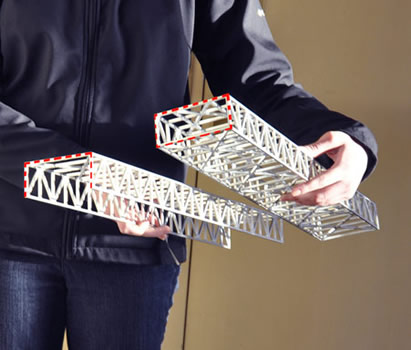
Bridge Deck (Prototype) Models
 |
Original Bridge Deck Shape
This is a scale model of a 500-foot (152-meter) length of the original deck structure of the Golden Gate Bridge, without the roadway on top. The trusses on the sides, along with the framing on top that supports the roadway, form an upside-down U-shape.
|
 |
Retrofitted Bridge Deck Shape
This model shows the Bridge deck today. The difference from the original design, shown above, is the addition of bottom bracing. The cross section is a closed shape.
|
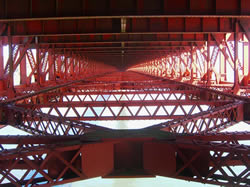 |
Trusswork under the Bridge deck
Image shows the new bracing that is visible in the bottom level.
|
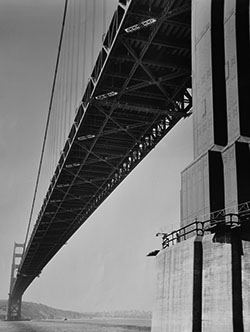 |
Photograph of the completed lower lateral deck bracing from the Golden Gate Bridge, Highway and Transportation District - A photograph from beneath the Bridge deck c. 1954 showing the diagonal bracing added across the underneath portion of the deck to stiffen its resistance to twisting in the wind. |
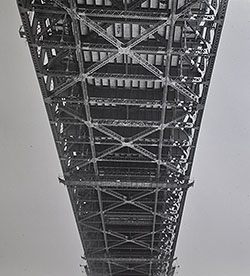 |
Photograph of the completed lower lateral deck bracing from the Golden Gate Bridge, Highway and Transportation District - An April 20, 1954 photograph taken from beneath the Bridge showing the diagonal bracing added across the underneath portion of the deck to stiffen its resistance to twisting in the wind. |
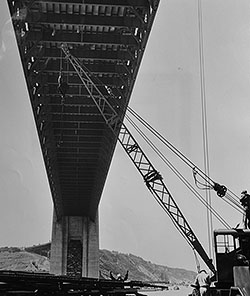 |
Photograph of the deck prior to installation of lower lateral bracing from the Golden Gate Bridge, Highway and Transportation District - Steel trusswork across the bottom of the deck, to improve its resistance to twisting in the wind, is pictured about to be installed. |
Explore this Topic Further
Golden Gate Bridge Deck Vibration, Stability, and Retrofit
Golden Gate Bridge Can “Take It” from the Sausalito News - 1951 (grade 3 to adult)
This article from the December 6, 1951 issue of the Sausalito News states that 89 mph winds caused the bridge to oscillate 42 inches up and down and 24 inches side to side. District spokesman James Adam stated that the bridge was closed “due to the wind forcing vehicles from one lane to the other.”
Bridge Deck Aerodynamics (all ages)
This exhibit, in the visitor area at the San Francisco end of the Bridge, demonstrates the relationship between the shape of the bridge deck cross section and the stability of a suspension bridge.
How the Bridge Vibrates (all ages)
This exhibit, in the visitor area at the San Francisco end of the Bridge, demonstrates four modes of vibration of the Bridge, including the twisting (wind flutter) mode.
Video of Bridge Vibration Modes by Dave Fleming of the San Francisco Exploratorium (all ages)
Dave Fleming demonstrates the vibration model of the Bridge that is part of the outdoor museum in the visitor area at the San Francisco end of the Bridge. From 0:55 to 1:29 minutes he demonstrates two torsional modes of vibration. (2:12 minute video)
Lower Lateral Bracing 1951-1957: Chapter 1 of The Golden Gate Bridge, Report of the Chief Engineer, Volume II Frank L. Stahl, Daniel Mohn and Mary C. Currie (2007) (grade 9 to adult)
The Golden Gate Bridge, Highway and Transportation District compiled this detailed account of the history and planning of the Bridge. Chapter 1 is a 1970 report by Clifford E. Paine that provides a detailed and somewhat technical presentation of the design and construction specifications for the bracing system added to the bottom of the bridge deck in 1953-1954.
Before & After the Torsional Resistance Retrofit from the Golden Gate Bridge, Highway and Transportation District
Princeton University civil engineering professor Dr. Maria Garlock shows how this exhibit, designed by Elizabeth Deir, a student of hers, lets the visitor feel the difference in the torsional (twisting) stiffness of the original Bridge deck as compared to the deck after its wind engineering retrofit was implemented in the 1950s.
Tacoma Narrow Bridge Vibration and Collapse
Tacoma Narrows Bridge Collapse (all ages)
This 1940 news clip documents the large vibrations and then collapse of the Tacoma Narrows Bridge in 42 mile-per-hour (68 kilometers per hour) winds. (2:35 minute video)
Lessons Learned from the Collapse of the Tacoma Narrows Bridge from Washington State Department of Transportation (grade 6 to adult)
The collapse of the Tacoma Narrows Bridge reinforced for designers of the importance of deck weight and stiffness in the stability of a suspension bridge deck. The “torsional flutter” of the bridge due to wind excitation was not anticipated.